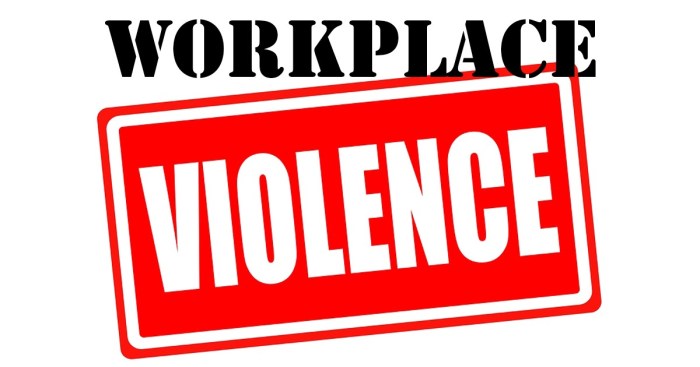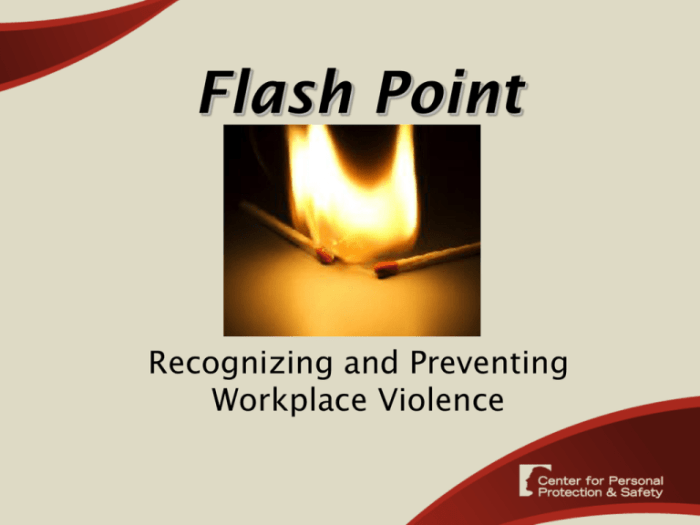Recognizing and preventing workplace violence cvs – Workplace violence remains a pressing concern, with its prevalence and devastating consequences affecting organizations and individuals alike. Recognizing and preventing workplace violence (WPV) is crucial for creating a safe and productive work environment. This comprehensive guide delves into the different types of WPV, provides practical strategies for prevention, and Artikels essential steps for responding to and managing WPV incidents.
Recognizing Workplace Violence

Workplace violence is a serious problem that can have devastating consequences for employees, employers, and the community as a whole. It is important to be aware of the different types of workplace violence, the common scenarios in which it occurs, and the prevalence of this issue.
Workplace violence can take many forms, including physical assault, verbal abuse, threats, and intimidation. It can be perpetrated by employees, customers, or other individuals who have access to the workplace. Common workplace violence scenarios include:
- Arguments between employees
- Robberies or assaults by customers
- Violence by disgruntled employees
- Domestic violence spilling over into the workplace
Workplace violence is a significant problem, with an estimated 2 million incidents occurring each year in the United States alone. It is important to be aware of the signs of workplace violence and to take steps to prevent it from occurring.
Preventing Workplace Violence

Creating a violence-free workplace culture is essential for preventing workplace violence. This can be achieved by:
- Establishing clear policies and procedures for dealing with workplace violence
- Providing training for employees on how to recognize and prevent workplace violence
- Creating a supportive work environment where employees feel comfortable reporting incidents of workplace violence
Management plays a critical role in preventing workplace violence by:
- Setting a positive example by treating employees with respect
- Enforcing workplace violence policies and procedures
- Providing support to employees who have been victims of workplace violence
Employees can also play a role in preventing workplace violence by:
- Being aware of the signs of workplace violence
- Reporting any incidents of workplace violence to management
- Creating a supportive work environment where employees feel comfortable speaking up about concerns
Responding to Workplace Violence
If workplace violence occurs, it is important to take the following steps:
- Call 911 immediately
- Evacuate the area if possible
- Stay calm and follow the instructions of law enforcement
- Report the incident to management
- Seek medical attention if necessary
It is also important to report workplace violence to the Occupational Safety and Health Administration (OSHA). OSHA can investigate the incident and issue citations to employers who have violated workplace safety laws.
Victims of workplace violence may experience a range of emotions, including fear, anger, and anxiety. It is important to seek professional help if you have been a victim of workplace violence.
Training and Education: Recognizing And Preventing Workplace Violence Cvs

Workplace violence training is essential for preventing and responding to workplace violence. Training should cover the following topics:
- The different types of workplace violence
- The common signs of workplace violence
- The steps to take if workplace violence occurs
- The importance of reporting workplace violence
There are a variety of different types of workplace violence training available, including:
- Online training
- In-person training
- Interactive training
When developing a workplace violence training program, it is important to consider the following factors:
- The size of the organization
- The industry in which the organization operates
- The specific risks of workplace violence faced by the organization
Case Studies

There are a number of high-profile cases of workplace violence that have occurred in recent years. These cases provide valuable lessons about the importance of preventing and responding to workplace violence.
One example is the Virginia Tech shooting in 2007, in which a student killed 32 people and wounded 17 others. This case highlighted the need for colleges and universities to have comprehensive workplace violence prevention plans in place.
Another example is the Aurora theater shooting in 2012, in which a gunman killed 12 people and wounded 70 others. This case highlighted the need for businesses to have active shooter response plans in place.
These cases are just two examples of the many workplace violence incidents that have occurred in recent years. It is important to learn from these cases and to take steps to prevent similar incidents from happening in the future.
Best Practices
There are a number of best practices that organizations can follow to prevent and respond to workplace violence. These include:
- Creating a workplace violence prevention plan
- Providing workplace violence training to employees
- Establishing a system for reporting workplace violence
- Investigating all reports of workplace violence
- Taking appropriate disciplinary action against employees who engage in workplace violence
Technology can also play a role in preventing and responding to workplace violence. For example, video surveillance can be used to deter crime and to identify suspects in the event of an incident. Access control systems can be used to restrict access to certain areas of the workplace and to track the movement of individuals.
There are a number of organizations that have successfully implemented workplace violence prevention programs. For example, the National Institute for Occupational Safety and Health (NIOSH) has developed a number of resources to help employers prevent workplace violence. The Occupational Safety and Health Administration (OSHA) also has a number of resources available to help employers prevent and respond to workplace violence.
Query Resolution
What are the most common types of workplace violence?
WPV can manifest in various forms, including physical assaults, threats, verbal abuse, bullying, and sexual harassment.
What are some warning signs of potential workplace violence?
Be aware of changes in behavior, such as increased irritability, isolation, or preoccupation with violent topics.
What should I do if I witness or experience workplace violence?
Report the incident immediately to your supervisor or designated safety personnel. Ensure your safety and seek medical attention if necessary.